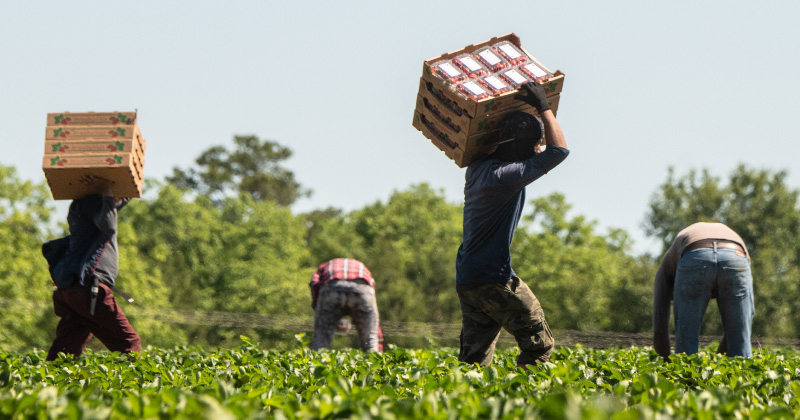
Agricultural workers are particularly vulnerable to COVID-19, due to a long list of inequities in health, work, and lifestyle. As essential workers, agricultural workers are at increased risk of exposure in the workplace, as they continue to work in the fields and orchards despite local outbreaks. Federal guidance to protect agricultural workers from COVID-19 is non-mandatory and only some states and cities have issued emergency regulations that apply to agricultural workers, resulting in uneven implementation of protections. Amid a dearth of regulatory protection, some agricultural workers have reported fear of retaliation or job loss if they submit complaints about or requests for safety and health measures to prevent COVID-19 exposure on the job, like physical distancing, face masks, and opportunities and supplies to wash or disinfect hands. Many agricultural workers live in farm-provided housing. Crowded and often unsanitary living conditions may spread COVID-19 among agricultural workers even if the workplace itself encourages COVID-19 prevention practices.
Additionally, agricultural workers experience a wide range of negative social determinants of health that put them at increased risk of COVID-19 exposure and illness. Low income; fear of exposure of immigration status; poor or limited access to healthy food, clean air and water; language and cultural barriers; poor integration into the community; low education and literacy levels; rural locations; and migration itself can each negatively impact an agricultural worker’s health, leaving workers with chronic health conditions that may increase their risk of infection. Thus far, COVID-19 infection rates confirm the many disparities that agricultural workers face. Outbreaks have been tracked at farms across the country and episodic data have shown high infection rates among some agricultural workers.1-3 In Monterey County, agricultural workers were found to be three times more likely to contract COVID-19 than non-agricultural workers.4 While data specifically for agricultural workers aren’t comprehensive, the majority of agricultural workers in the United States are Latinx; indeed, Latinx communities have had higher rates of COVID-19 infection.5-8
With fewer resources and community connections, agricultural workers struggle to access health care and/or isolate if they do fall ill. Agricultural workers without authorization to live and work in the US are ineligible for federal wage relief and other protections for workers who contract COVID-19. Many do not have a safety net if they must miss work: little to no savings, no health insurance, and, for migrant workers in particular, few community connections or resource access. As a result, accessing health services is difficult.
Very early on in the COVID-19 pandemic, clinicians at community health centers recognized the unique vulnerabilities of agricultural workers to COVID-19. Many quickly mobilized, reaching out to community organizations, health departments, and farms, to build coalitions and partnerships to protect workers. One particularly unique result of this mobilization is the increase in collaboration with farmers, who had previously been unwilling to talk about health and safety with health workers and health advocates. In Monterey, California, local clinicians and advocates considered hiring a mediator for the first meeting of an agricultural worker health coalition there, illustrating the fraught relationship between advocates and farm owners before COVID-19. “When you look at the history of the county, we don’t have many opportunities where we have sat together,” admitted Pedro Moreno, MD, at Alisal Health Center, whose coalition is highlighted in this issue. “This was an opportunity to forget the past and try to look at the present – and, more importantly, at the future.” Such sentiments – and surprise at the speed at which partnerships with farm owners have developed – have been repeated by clinicians across the country. Many are hopeful that the relationships built during this pandemic may allow for greater communication and partnership in the future. What partnerships have you built at your community health center? Email us at: chutkins-seda@migrantclinician.org.
1 Villarejo D. CIRS Research Report: Increased Risks and Fewer Jobs: Evidence of California Farmworker Vulnerability During the COVID-19 Pandemic. California Institute for Rural Studies, Inc. 25 July 2020. Accessed 15 September 2020. Available at: https://www.cirsinc.org/phocadownload/farmworker_vulnerability_covid-19_research-report_final_villarejo_07-26-2020.pdf
2 Douglas L. Mapping Covid-19 outbreaks in the food system. Food & Environment Reporting Network. 22 April 2020. Accessed 15 September 2020. Available at: https://thefern.org/2020/04/mapping-covid-19-in-meat-and-food-processing-plants/
3 Evich HB, Bustillo X, and Crampton L. Harvest of shame: Farmworkers face coronavirus disaster. Politico. 8 September 2020. Accessed 15 September 2020. Available at: https://www.politico.com/news/2020/09/08/farmworkers-coronavirus-disaster-409339
4 Villarejo D. Increased Risks and Fewer Jobs: Evidence of California Farmworker Vulnerability During the COVID-19 Pandemic. California Institute for Rural Studies, Inc. 25 July 2020. Accessed 29 September 2020. Available at: https://www.cirsinc.org/phocadownload/farmworker_vulnerability_covid-19_research-report_final_villarejo_07-26-2020.pdf
5 Health Equity Considerations & Racial & Ethnic Minority Groups. Centers for Disease Control and Prevention. Updated 24 July 2020. Accessed 10 September 2020. Available at: https://www.cdc.gov/coronavirus/2019-ncov/community/health-equity/race-ethnicity.html
6 Demographic Trends of COVID-19 Cases and Deaths in the US Reported to CDC. Centers for Disease Control and Prevention. Updated 10 September 2020. Accessed 10 September 2020. Available at: https://covid.cdc.gov/covid-data-tracker/#demographics
7 The COVID Racial Data Tracker. Available at: https://covidtracking.com/race
8 COVID-19 Health Equity Interactive Dashboard. Emory University. Available at: https://covid19.emory.edu/
Read this article in the Fall 2020 issue of Streamline here!
Sign up for our eNewsletter to receive bimonthly news from MCN, including announcements of the next Streamline.